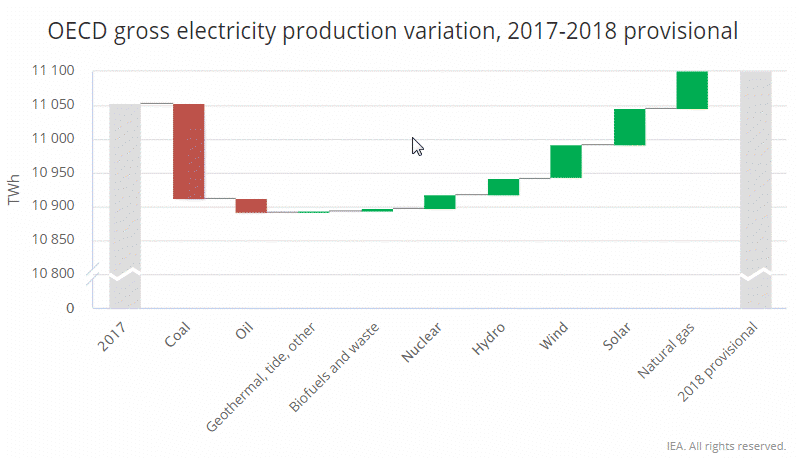
Graphics from IEA webpage - see link above.
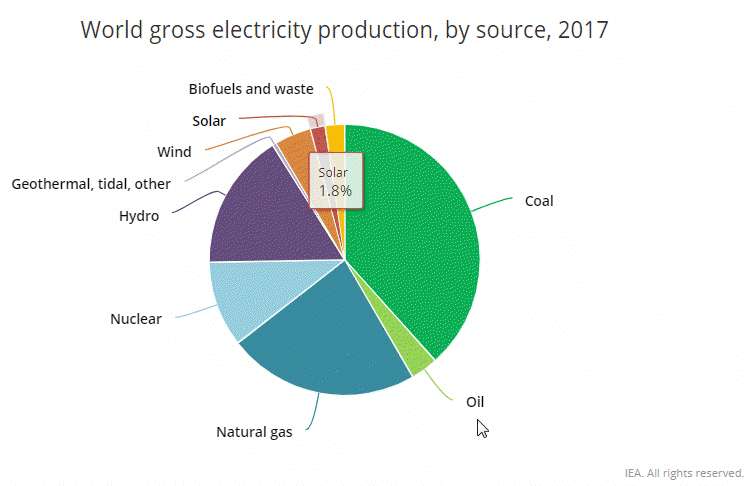
Graphics from IEA webpage - see link above.
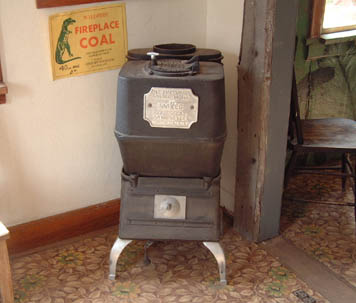
Coal has a long history of use as an energy source. It was the fuel of the industrial revolution and although many other energy sources have replaced some of the applications in which coal was used, it still is an important fuel for electrical generation. For more information about the history of fuels consumed for energy generation, go here.
Watch the 3-D animation from First Energy, an electricity generating power company to find out. It will provide you with an overview of the process of converting coal into electricity, the environmental clean up of by-products produced in the combustion of the coal, and how the electricity is transmitted for use. According to the IEA (International Energy Agency, coal is the resource that accounts for the largest percentage in electricity generation world-wide.

Graphics from IEA webpage - see link above.
Graphics from IEA webpage - see link above.
In 2010 coal was responsible for about 44.9% of the electricity generated in the United States. Natural Gas was a distant second with 23.8% while conventional hydroelectric generation, a primary resource in the Pacific Northwest, came in 4th with a 6.2% share. In 2010 the EIA projected that the role of coal will not diminish significantly through 2035. However, the EIA data for 2016 shows that electricity generation using natural gas increases to about 33% and coal dropped to 32% in the U.S.
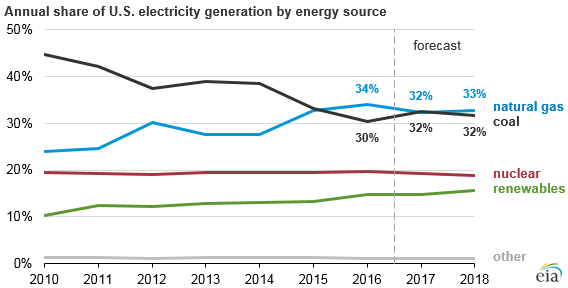
Although there are a number of different designs for coal-fired powerplants, all use the heat produced in the combustion reaction to heat water to steam. The gaseous flowing steam pushes the blades of a turbine (similar to how wind would move the blades) which turns the shaft of a generator producing the electricity. This video shows how steam pushes the blades of a turbine:
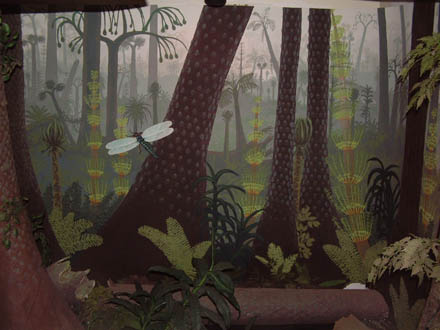 Coal
is the compacted and preserved remains of plant matter. Although most plant
matter decomposes where it falls, when plant life containing cellulose-rich
stems and leaves is highly abundant and special conditions exist, the plant
matter does not totally decompose and is preserved in fossilized form. These
types of plants had evolved by the Devonian Period and coal deposits are found
in rocks dating from the Devonian period forward. Many coal deposits in Europe
and North America date from the Carboniferous periods of the Paleozoic when
these areas were covered with forests dominated by large ferns and scale trees.
Learn more about geologic time here.
Coal
is the compacted and preserved remains of plant matter. Although most plant
matter decomposes where it falls, when plant life containing cellulose-rich
stems and leaves is highly abundant and special conditions exist, the plant
matter does not totally decompose and is preserved in fossilized form. These
types of plants had evolved by the Devonian Period and coal deposits are found
in rocks dating from the Devonian period forward. Many coal deposits in Europe
and North America date from the Carboniferous periods of the Paleozoic when
these areas were covered with forests dominated by large ferns and scale trees.
Learn more about geologic time here.
Most coals that are mined for energy production are humic coals which are derived
from peat. These coals are examples of organic sedimentary rocks and composed
macerals. If you look at the picture the picture of a lump of coal, you can
see stratification which results from the organic matter being deposited layer upon
layer. The formation of humic coals begins when plant debris accumulates in
a swamp where the stagnant water prevents oxidation and total decomposition
of the organic matter. These swamps are called peat swamps. It is estimated
that about 10% of the plant matter is converted to peat in these swamps. It appears
that many coal deposits formed when peat deposits in near-coastal basins subsided
allowing the sea to flood the area covering the peat with sand and mud. http://chemistry.anl.gov/carbon/coaltutorial/coalgeneral.html#coalification
A coal seam in the Powder River Basin, WY 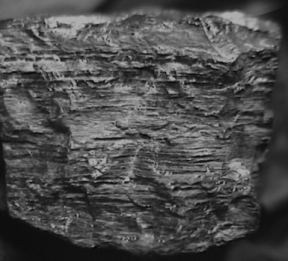 Much
of the area that now is found in Europe and North America were located closer to the equator during the Devonian and Carboniferous periods, and the seawater
was warm allowing lime muds to accumulate on top of the peat deposits. Over
time these areas experienced cyclical periods of subsidence and reemergence.
As a result many coal deposits are composed of layers of coal separated by layers
of sandstone, shale or limestone. The coal
Much
of the area that now is found in Europe and North America were located closer to the equator during the Devonian and Carboniferous periods, and the seawater
was warm allowing lime muds to accumulate on top of the peat deposits. Over
time these areas experienced cyclical periods of subsidence and reemergence.
As a result many coal deposits are composed of layers of coal separated by layers
of sandstone, shale or limestone. The coal 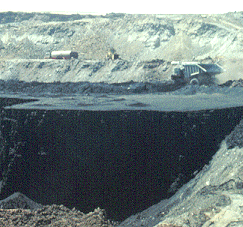 layers
range in thickness from a few centimeters to 50 feet or more. Although coal
formation began in the Devonian, the great coal beds found in Australia, the
eastern United States and England were formed during the Carboniferous periods
and those of the western U.S. were formed during the Jurassic to the mid-Tertiary.
layers
range in thickness from a few centimeters to 50 feet or more. Although coal
formation began in the Devonian, the great coal beds found in Australia, the
eastern United States and England were formed during the Carboniferous periods
and those of the western U.S. were formed during the Jurassic to the mid-Tertiary.
http://enterprise.cc.uakron.edu/geology/natscigeo/Lectures/smrocks/sedmeta.htm#sedimentary
| Formation of Coal Video |
In the peat swamp as dead plant matter accumulates, aerobic bacteria rapidly oxidize cellulose and other components producing methane (CH4), carbon dioxide and ammonia (from the nitrogen containing components). The resulting decomposed material compacts about 50% and is largely composed of lignin, a complex, 3-dimensional polymer rich in benzene rings. These bacteria quickly use up the available oxygen and die ending the first stage of the process. Anaerobic bacteria take over the decomposition process. They produce acids as metabolic waste products. When the pH reaches ~4, these bacteria die. The product at this stage is a gel-like material called Gytta. When the Gytta is buried to a depth of 2,000 to 3,000 feet, the temperature is about 100oC and a thermal process known as bituminization begins. At this temperature water and other volatiles are driven off. Learn more about how swamps are converted to coal here.
http://www.lignin.info/01augdialogue.html |
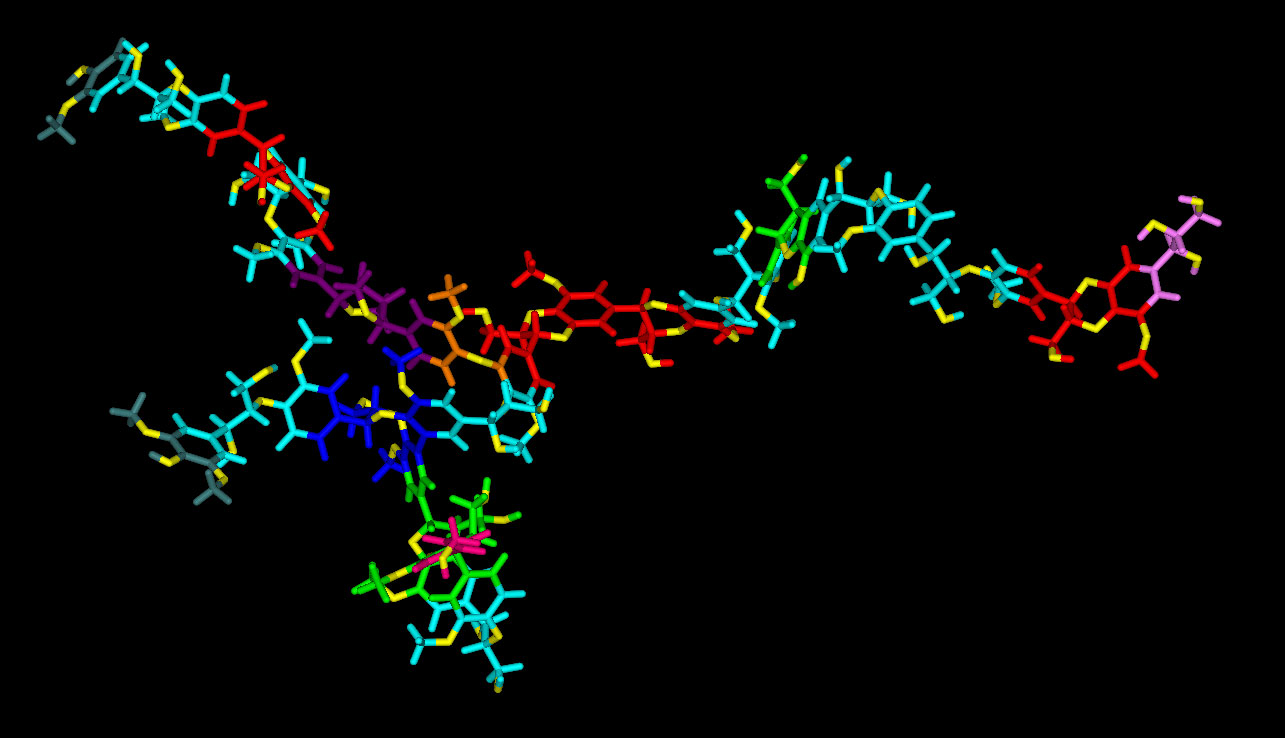
http://www.lignin.info/01augdialogue.html |
As this decomposed peat is buried deeper and deeper, the pressure and temperature to which it is exposed increases causing chemical reactions to occur which reduce the lignin (remove oxygens via expulsion of carbon dioxide and water). In this process, carbon-carbon bonds form between the aromatic rings producing the hard, black carbon-rich material we call coal. Under extreme conditions of pressure and temperature, the end product or most reduced form is graphite. Graphite is a form of carbon in which the carbon layers are arranged into layers of fused aromatic rings. The process of converting organic plant material into coal is called coalification.
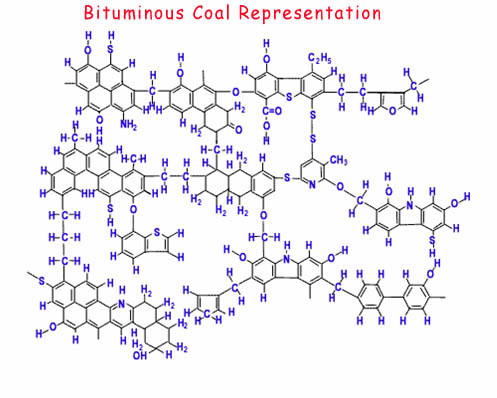 |
|
Since different coal beds form under different conditions of temperature and pressure, the amount of oxygen removed will differ in different coal samples. The products of coalification are divided into four major categories based on the carbon content of the material. It is the carbon content of the coal that supplies most of its heating value. The greater the carbon to oxygen ratio the harder the coal, the more reduced the state of the carbons and the more potential energy it contains. These major categories may be divided into subdivisions such as high volatile A or high volatile B bituminous coal.
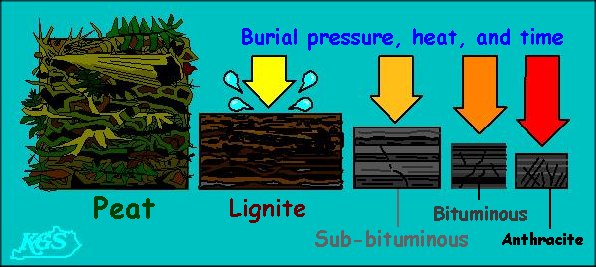 http://www.uky.edu/KGS/coal/coalkinds.htm |
Peat |
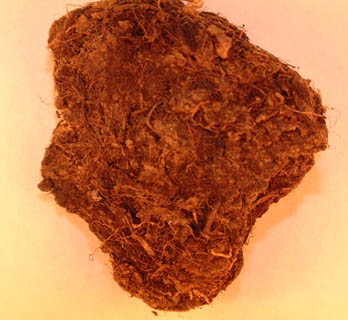
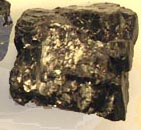 Notice the
obvious presence of plant matter present in the sample of peat at the left.
As coalification proceeds the product becomes more "mineral-like"
in its appearance. The higher the rank of a piece of coal, the harder and more
lustrous it is. Compare the peat to the anthracite shown at the right which
is quite hard, very shiny and looks like a "mineral".
Notice the
obvious presence of plant matter present in the sample of peat at the left.
As coalification proceeds the product becomes more "mineral-like"
in its appearance. The higher the rank of a piece of coal, the harder and more
lustrous it is. Compare the peat to the anthracite shown at the right which
is quite hard, very shiny and looks like a "mineral".
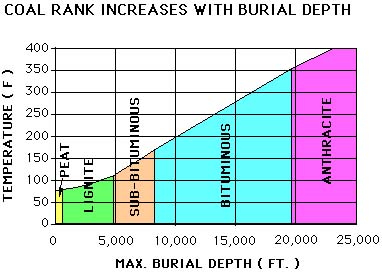
As you travel from the earth's surface toward the center, temperature increases. This geothermal gradient averages about a 1.5oF increase per 100 feet of depth. As coal is buried deeper and deeper by accumulating sediments, much or the water and volatile components are extruded (devolatilization) leaving behind fixed carbon, ash, sulfur often in the form of pyrite and other trace elements. The normal geothermal gradient will produce bituminous coals at burial depths between 8,500 and 20,000 feet.
http://www.geocraft.com/WVFossils/coal_rank.html
Lignite is geologically the youngest of the coal types. It is soft and brown in color. It is composed primarily of compressed, dehydrated woody material. The fixed carbon content ranges from about 20-35% by mass. This type of coal often is called brown coal. It is used mainly for electric power generation and produces 9-17 million BTU/ton. Lignite deposits are found in Texas, Montana, North Dakota and the Gulf Coast region.
Sub-bituminous coal is typically dull black in color. It has a carbon content ranging from 35-45% and produces 16-24 million BTU/ton. Although the heat value of sub-bituminous coal is lower than bituminous, it tends to be relatively low in sulfur content and cleaner burning than other types of coal. This type of coal is found in a number of Western states and Alaska.
Bituminous coal is soft, dark and dense. It has little water content and has lost most other impurities except for sulfur. It is ignited easily producing a smoky yellow flame, ash, and volatile sulfur compounds. The carbon content ranges from 45-80% and produces 19- 32 million BTU/ton. Bituminous coal is the most commonly found type of coal in the U.S. with major deposits in the Appalachians, the Great Plains, and the Colorado Plateau. It is used to generate electricity and is converted to coke for use in the steel industry.
Anthracite has the highest carbon content (80-96%) and produces the most energy
per ton (20-28 million BTU/ton). It burns very cleanly
and is sometimes called "smokeless" coal. 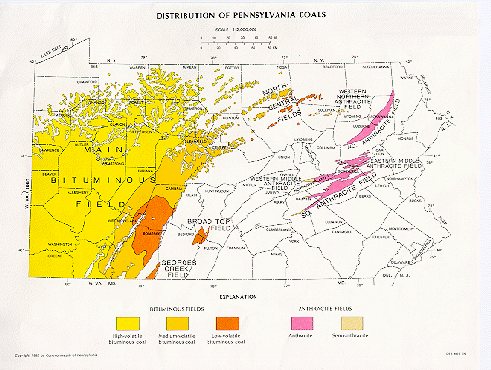 Whereas other ranks of coal
are classed as sedimentary rocks, anthracite is metamorphic. Anthracite forms
when coal deposits are exposed to abnormally high temperatures often resulting
from tectonic mountain building episodes. Anthracite is a relatively rare form
of coal which in the U.S. is found primarily in a small area of Pennsylvania.
These deposits were formed during the Allegheny Orogeny of the Carboniferous
Period when the the continents of North America, South America and Europe collided
forming the supercontinent Pangea. This collision formed the Appalachian Mountains
which at the time reached elevations of 15,000 to 23,000 feet burying the forming
coal to great depths. Subsequent glacial action eroded the Appalachians to the
highlands they are today. It is estimated that nearly 95% of the anthracite
formed in this region eroded away before man began mining coal.
Whereas other ranks of coal
are classed as sedimentary rocks, anthracite is metamorphic. Anthracite forms
when coal deposits are exposed to abnormally high temperatures often resulting
from tectonic mountain building episodes. Anthracite is a relatively rare form
of coal which in the U.S. is found primarily in a small area of Pennsylvania.
These deposits were formed during the Allegheny Orogeny of the Carboniferous
Period when the the continents of North America, South America and Europe collided
forming the supercontinent Pangea. This collision formed the Appalachian Mountains
which at the time reached elevations of 15,000 to 23,000 feet burying the forming
coal to great depths. Subsequent glacial action eroded the Appalachians to the
highlands they are today. It is estimated that nearly 95% of the anthracite
formed in this region eroded away before man began mining coal.
A Map of Pennsylvania Anthracite (pink) Coal Deposits
http://www.dep.state.pa.us/dep/deputate/enved/go_with_inspector/coalmine/Anthracite_Coal_Mining.htm
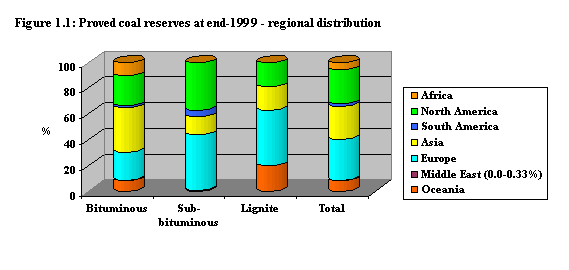
Both North America and Asia possess over 25% and Europe about 30% of the world's coal reserves . North American reserves are about half bituminous coal and half sub-bituminous/lignite; Asia has a significantly higher proportion of bituminous coal and sub-bituminous/lignite coals are more prevalent in European reserves,
World Energy Council (http://www.worldenergy.org/wec-geis/publications/reports/ser/coal/coal.asp)
The following map shows the major coal deposits in the United States:

American Coal Foundation (http://www.teachcoal.org/aboutcoal/articles/coalreserves.html)
Coal fueled the Industrial Revolution. It was a major resource used in the opening of the western regions of North America. In order to use coal as an energy source, the coal needed to be mined. Mining has always been a difficult and dangerous profession. Watch the videos and then follow the links below to learn about the different types of mining used to "harvest" coal and to learn a little about the history of coal mining.
![]()
|
The Bankhead Story from Arlene Courtney on Vimeo. The Bankhead Story from Arlene Courtney on Vimeo. |
The Bankhead StoryThis is the story of an early 20th Century coal mining town that existed for about 20 years to provide coal for the Canadian Pacific Railway. Learn a bit about the history of Rocky Mountain coal mining by joining this trip to the former town site which is located in Banff National Park, Alberta, Canada. |
![]()
|
|
This vintage 1920s silent film (originally a 16mm hand-cranked movie) shows a typical day of producing coal in a northeastern Pennsylvania anthracite coal mine. The film begins with the miners arriving at the mine and switching into mining clothes with their street clothes held up by lines near the ceiling. Each miner receives a head lamp and is issued a case of dynamite. Before entering the mine the miner updates the peg board taking the token that allows the mine operator to know exactly who is in the mine at any given time. In the shaft the miners drill a hole in the face of the coal seam, pack it with the explosives and blast a section of the coal face. The miner and his helper shovel the coal into a cart for movement to the main gangway where the coal is transferred into larger carts which are hauled away by mules. In addition to the mule drivers and "spraggers" the film shows the coal breaker in the tipple where boys and disabled men separate the slate from the coal. The culm (waste rock) is transported and dumped formime giant piles. Finally the coal is washed and sorted into various sizes: stove, egg, nut and shipped out in railroad cars. |
Watch this video showing coal mining in the 1930s.
![]()
Mining Appalachian Anthracite Through History: Part 1, Part 2, Part 3
Take a Ride into a Modern Mine (CBS 60 minutes segment)
When Coal Was King; Coal Mining in Western Canada
Surface mining; underground mining; coal preparations plants
Visit the Black Thunder Coal Mine, a strip mine
The Life and Work of the Early Coal Miners:
Today's Surface Mining
Although coal is still mined in underground mines, surface mining has become an increasingly important method of extracting coal. For example, the Powder River Basin of Wyoming contains seams of coal that are not co-mixed with rock debris and can be 100 or more feet thick. The coal from the Powder River Basin has another very desirable feature; it has a very low sulfur content which makes it a cleaner electricity generating energy source than coal from many other areas. When coal is combusted (burned), sulfur contaminants are also oxidized into sulfur dioxide which, if not removed, can combine with water to form the sulfuric acid which can result in increasing the acidity of rain. Exactly how these unusually "pure" coal deposits were formed remains a bit of a geologic mystery.
These coal beds lie very close to the surface and can be accessed by blasting the surface rock (called overburden) and then collected by huge mechanized shovels that deposit the pure coal into huge trucks. These trucks transport the coal from the bed to railroad cars that take it to coal fired powerplants all across the United States. This short video shows how this Powder River Basin coal is mined:
Perhaps the most controversial current method of mining coal is a process referred to as "mountain-top removal". This is a process by which coal seams in the Appalachian Mountains of the eastern United States are accessed by blasting away the the tops of mountains to expose the seams rather than burrowing to the mountain with shafts. A battle is raging between environmentalists, miners, the local population and the mining companies. The following video is an except from the award-winning documentary "The Appalachians" by Mari-Lynn Evans and Phylis Geller which explains the process of mountain-top removal.
|
|
It is interesting to see how mountain-top removal has changed the face of the Appalachian landscape. Follow the link to do a virtual fly-over of mountain-top removal sites in Wise County of western Virginia. Watch this time-lapse evolution of the Hobet Coal Mine in Boone County West Virginia from 1984 to 2009 via images acquired by NASA's Landsat 5 satellite and compiled by National Geographic.
![]()
Coal is king when it comes to electricity production. According to the Energy Information Agency (EIA), coal provided 44.9% of the electricity generated in the United States in 2010. Natural Gas was a distant second with 23.8% while conventional hydroelectric generation is a primary resource in the Pacific Northwest, it comes in 4th with a 6.2% share.
![]()
Here are some books that are written for the layman that you might find interesting reads.
"Coal - A Human History" by Barbara Freese .... a journey through history to learn more about the social, environmental and political history of coal and its shaping of society (also available as an audiobook from Audible.com)
"King Coal" by Upton Sinclair ... a novel by the author of The Jungle based on the coal strikes of 1914 1n1 1915 and how they lead to unionization
"The Map that Changed the World" by Simon Winchester ... the story of the man who changed our understanding of geologic history and his efforts to gain acceptance for his discoveries (also available as an audiobook from Audible.com)
Something's Rising: Appalachians Fighting Mountaintop Removal by Silas House and Jason Howard ... twelve Appalachian natives speak out
Watch clips from Deep Down a video that aired on the PBS Point of View Series. Go to the website for the video for more information including a Virtual Mine Game that you can play.
![]()
Last modified 14 November 2019